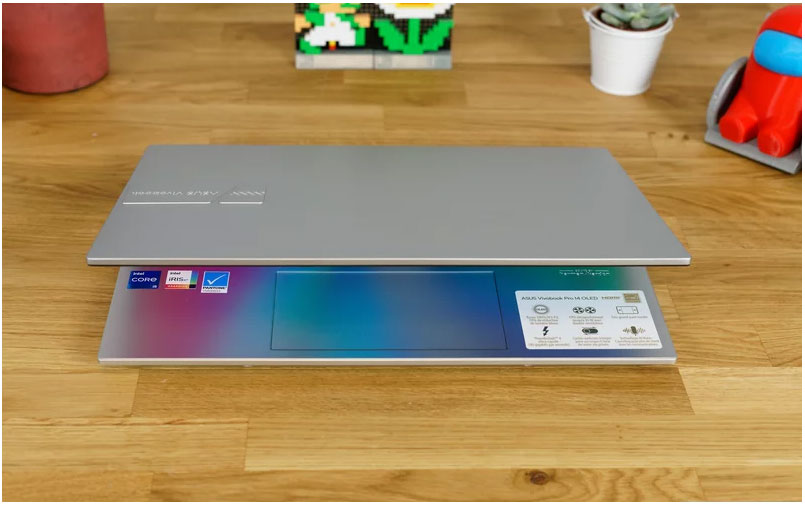Asus Vivobook Pro 14 OLED
The Asus Vivobook Pro 14 Oled is a laptop designed for content creators. If the presence of an 11th generation Intel processor is quite classic, it stands out by hosting an Oled screen.
Presentation
Announced in September 2021, the Asus Vivobook Pro 14 Oled is starting to be available on the French market. Intended for content creators and equipped with Intel Core i5 or i7 of 35 W (Intel -H series), it promises good performance, especially since a dedicated graphics card can be added depending on the configuration.
Construction
The Asus Vivobook Pro 14 Oled has an aluminum cover with an embossed Vivobook badge. The rest of the PC is entirely made of plastic, from the chassis to the keyboard piano. Only the screen border is black with a matte effect that contrasts with the brightness of the Oled panel.
When opened, the backlit keyboard reveals its gray keys on a gray background. An aesthetic choice, but one that makes the keys unreadable with the white backlight during the day. The highest level of backlighting, however, mitigates this phenomenon. The touch offered by the keyboard lacks rigidity at the end of the stroke. In addition, the center of the keyboard sinks slightly, accentuating this feeling. The lack of a fingerprint reader to quickly unlock the PC is problematic because, as we will see, the webcam is not Windows Hello compatible.
The touchpad is relatively large (13 cm) for a 14-inch chassis. The set of Windows 10 gestures is well taken care of and dragging and dropping a tap in the center of the pad is easily done. Asus has added the NumpPad feature, which allows you to overlay the numeric keypad. A long press in the upper right corner makes it appear, while a long press on the upper left corner changes its brightness.
Connectivity consists of two USB 2.0 ports on the left edge and a USB-C 3.2 port, Thunderbolt 4 port, HDMI 1.4, microSD port and headphone jack on the right side of the PC. For network connectivity, Asus uses an Intel AX201 chip offering wifi 6 at 2400 Mb/s and Bluetooth 5.2.
The HD webcam has a mechanical cover, but lacks the Windows Hello unlock feature. The image quality is just acceptable.
Cooling is provided by two fans and two heatpipes. Our test version (Vivobook Pro 14 Oled S3400PA) does not have a dedicated graphics card, so the Intel Core i5-11300H is particularly well cooled. This is confirmed on the thermal imaging. Thus, after more than 15 minutes of encoding, we found less than 40°C at the air outlets on the screen. The keyboard remains relatively cool with a hot spot at 35°C to the right of the space bar.
Noise pollution is also contained since the Vivobook Pro 14 Oled stabilizes at 37.1 dB. This is a decent noise level after several dozen minutes of use. A slight murmur will be audible in open space by your neighbors.
The components are accessed by removing nine Torx screws. The shell is easily removed, but do not expect to expand the amount of RAM. Indeed, Asus has chosen LPDDR4 type RAM, so soldered. Only the battery, the SSD and the wifi card are accessible and removable.
Performance
The Asus Vivobook Pro 14 Oled has the reference S3400PA-KM0021T. It is equipped with an Intel Core i5-11300H processor with four hyperthreaded cores and can reach a boost frequency of 4.4 GHz with 35 W of TDP. In practice, the Core i5-11300H stabilizes at 3.58 GHz on a multithreaded encode. Asus touts a 45W mode that can be activated in the MyAsus software; however, we did not notice any noticeable gain with this High Performance mode. Finally, 8GB of RAM and a 512GB Intel 660P SSD round out our configuration.
The Core i5-11300H of the Vivobook Pro 14 Oled scores 82, which puts it between the AMD Ryzen 5 5500U of the Zenbook 13 Oled from the same manufacturer and the Intel Core i7-1165G7 processor of the HP Envy 14.
In use, the processor that "drives" the Vivobook will allow to do video editing and photo editing. However, the presence of a graphics card would be more than desirable to shorten the processing time of creative software.
In games, the 80 computing units of the Iris Xe graphics part are not really at their ease. In Diablo 3 in full HD and with all settings at maximum, we get an average of only 28 fps, making the game barely passable.
The 512GB Intel 660p SSD is close to 3GB/s read and just over 1600MB/s read. Being equipped with QLC chips, it sees its speeds drop to around 110 MB/s once the cache capacity is reached. Not much impact in everyday life, but if you handle very large files such as video rushes, the speeds will be strongly impacted.

Screen
The Asus Vivobook Pro 14 Oled features a 16:10 Oled panel displaying 2880 x 1800 px at 90 Hz. It is also HDR compatible with brightness peaks up to 600 cd/m². According to our calculations, it occupies 79% of the surface of the PC. The side borders are 8 mm and close to a centimeter for the upper part.
Under our probe, the Oled panel calibrated by Asus is close to perfection. The delta E is 2, the colorimetric drifts are therefore imperceptible to the naked eye (less than 3). The temperature is also particularly well controlled with 6522 K for an ideal value of 6500 K.
The brightness is limited to 396 cd/m² and can reach 621 cd/m² in HDR mode. The reflectance (percentage of reflected light) is 46%. This is still in the average of glossy tiles, but an anti-reflection treatment could have reduced this reflectance below 30% to make its use more pleasant near a window.
Nothing to complain about on the contrast and response time, the Oled panel providing by definition almost perfect blacks and therefore a rate of contrast almost infinite, as well as the response time, well below the millisecond.
Audio
The Vivobook Pro 14 Oled has two speakers located at each end under the palm rest. Because of their placement under the chassis, the sound will depend on the surface on which it is placed. Also, your hands can cover the palm rest and thus muffle the sound.
When listening, the speakers offer enough power to watch your series properly. There is a slight box effect due to the plastic chassis that vibrates at high volume.
The headphone jack provides an output voltage of 70 mVRMS, far too low to use, for example, headphones with a high impedance. Distortion and crosstalk are under control and therefore offer a clear sound and good stereo effects.

Autonomy
The Asus Vivobook Pro 14 Oled measures 31 x 22 cm and is just under 2 cm thick. Its weight reaches 1.46 kg on our scale and its charger adds 304 g to the whole. We also regret the use of a 65W charger with a proprietary format, especially since it uses a bulky power cable with a mickey plug (three-pin). A USB-C charger would have been a plus.
Regarding autonomy, the Vivobook reaches almost 7 h in video playback under Netflix, 6 h 55 min to be precise. Our protocol remains unchanged: reading a Netflix series under Chrome with the screen set to 200 cd/m² and headphones at 50% volume. By playing with the brightness and performance profiles, it should be possible to reach 8 h. For those who are more forward-thinking, the Thunderbolt socket accepts charging and can therefore help out on the move.
Conclusion
The Asus Vivobook Pro 14 Oled is far from being a professional laptop as its name might suggest. However, it is a versatile PC offering good performances, especially thanks to its beautiful Oled panel properly calibrated. The use of a 35W Intel Core i5 processor allows it to offer decent performance, but the lack of a dedicated graphics card to reduce processing time for creative tasks makes it miss its target: content creators. However, it will satisfy users who do not need a GPU.




